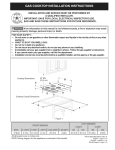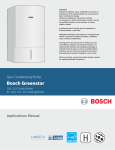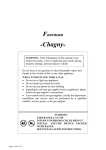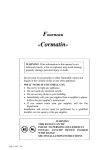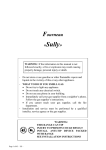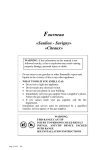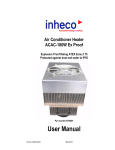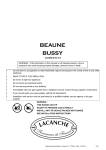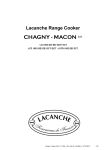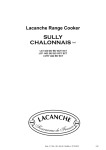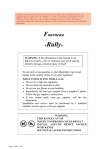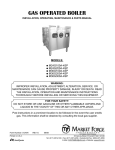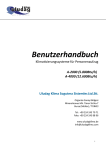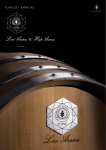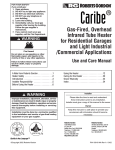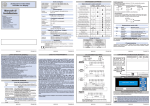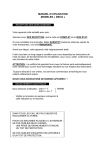Download USER`S MANUAL
Transcript
« LACANCHE» USER'S MANUAL IMPORTANT Provide adequate air supply during use of the appliance. Provide adequate clearances for servicing and proper operation by not obstructing front or side of appliances. WARRANTY The warranty is stated on the sales contract. Please contact your approved Dealer if any work has to be carried out under warranty. This warranty excludes damage resulting from incorrect installation, improper use or inadequate servicing. Page 26 of 43 – USA – Updated: 4/28/10 Page 27 of 43 – USA – Updated: 4/28/10 USER’S MANUAL CHAGNY SAFETY INSTRUCTIONS If the range is to be installed on an area covered with linoleum or any other floor covering, make sure that the floor covering can withstand 90 F (65°C) above room temperature without warping, shrinking or discoloring. Do not install the range over carpeting. Never store anything in the oven or on the cooktop. Flammable materials can catch fire, plastic items may melt or ignite and other types of items could be ruined. This appliance is for cooking. Based on safety considerations, never use the oven or cooktop to warm or heat a room. Doing so may result in carbon monoxide poisoning and overheating of the oven. Also, such use can damage the cooktop or oven parts. Never cover any slots, holes or passages in the oven bottom or cover an entire rack with materials such as aluminium foil. Doing so blocks air flow through the oven and may cause carbon monoxide poisoning. Aluminium foil linings may also trap heat, causing a fire hazard. Do not obstruct the flow of combustion or ventilation air to the appliance. Be sure a fresh air supply is available. When using the cooktop, do not touch the burner grates or the immediate surrounding area. Areas adjacent to the burners may become hot enough to cause burns. Do not hang articles from any part of the appliance or place anything against the oven. Some fabrics are quite flammable and may catch on fire. Children should not be left alone in the kitchen while the range is in use. Do not store items of interest to children over the unit. Children climbing to reach items could be seriously injured. Do not use aluminium foil to line any part of the oven or cooktop. When using the oven, do not touch the interior surfaces of the oven, the exterior area immediately surrounding the door or the back trim. Disconnect from main power supply before servicing. Page 28 of 43 – USA – Updated: 4/28/10 USER’S MANUAL CHAGNY GAS SURFACE BURNERS Highly valued by chefs because of their fast heating and ease of use, gas flame burners have always been traditional heat sources for cooking in large kitchens. Other heat sources have appeared in recent years but just as many users still prefer gas. It offers many advantages; gas provides a fast increase in temperature. The height of the flame can be checked easily at a glance in order to increase or reduce its power. Lacanche gas hobs for cook’s stoves are fitted with burners of different ratings. These automatically stabilised flame burners offer a very low slow setting to facilitate simmering or high heat for quick sealing. Depending on their rating, they are suitable for various types of cookware. Top burner 5000: is recommended for small sauceboats, small saucepans or blinis pans for example. A reducing adapter can be placed on the pan support in order to obtain greater stability (§ accessories) Top burners 15000 & 11000: are ideal for shallow frying pans, saucepans and cooking pots. Their high output provides very fast increases in temperature and very flexible use. Top burners 18000: is a high-power burner. It is especially recommended when using large cookware up to 40 cm in diameter for slow cooked dishes (pot au feu, cassoulet, jams, etc.) or dishes that have to be sealed quickly (fricassees, fritters, grilled meat). You will quickly learn how to use the various types of burners to achieve optimum cooking. Description: The burners are arranged on a stainless steel hob in various configurations depending on the model. Each burner is equipped with electric ignition. The various types of burners can be identified by their respective diameter. Designation Top burner 18000 Top burner 15000 Top burner 11000 Top burner 5000 Page 29 of 43 – USA – Updated: 4/28/10 Burner diameter Ø 107 mm Ø 90 mm Ø 72 mm Ø 55 mm USER’S MANUAL CHAGNY Use: Turn on main gas supply to range. IGN OFF Depress handle & rotate burner valve handle counter-clockwise to “IGN” position. IGN LOW HIGH Depress handle fully and wait for the burner’s thermocouple to heat up. Hold for 15-20 seconds after flame has lit. Igniters will spark (click) while handle is depressed. Release handle and rotate burner valve handle to “HIGH” position. Depress & rotate burner valve handle to the “LOW” position. Rotate burner valve handle to “OFF” position. Slightly depress handle to move into “OFF” position. LOW TOP BURNER A reduced flowrate position identified by the “LOW” mark produces the preset minimum burner power. This setting is adjustable behind the knob. Useful hint: CAUTION: During use of the cooking surface or oven, accessible parts may become Always choose a burner that matches the diameter of the cookware used. very hot during use. Warn users of the potential hazards. Cleaning: CLOSE THE MAIN GAS VALVE BEFORE CLEANING The burners are made in two parts in order to facilitate cleaning. Clean them separately. After removing the grates and burners, the cooking surface can be cleaned easily and thoroughly by simply using a sponge. Do not use scouring pads or abrasive products such as oven cleaners and stain removers. When cleaning, be careful not to splash liquid into the openings of the burners. Page 30 of 43 – USA – Updated: 4/28/10 USER’S MANUAL CHAGNY HEATING PLATE (A.K.A. Traditional Simmer Plate) The heating plate is a cast iron plate heated by a high-power gas burner. It can be used as a work surface and several saucepans can be placed on it at the same time. Cast iron stores and retains heat uniformly over its entire surface and it is possible to cook or simmer dishes depending on the temperature. Using the heating plate is ideal for cooking a pot au feu, coq au vin, warming a veal or fish stock or even binding a sauce. By removing the central plug of the plate, the burner can be used as a traditional flame burner. “TRADITIONAL” type gas hobs are equipped with a heating plate. Description: The heating plate is made entirely of cast iron. It consists of two parts, the main part rests directly on the cooking surface and the other removable plug part is located in the middle of the plate. DANGER: Temperature may exceed 300 °C/ 572 °F. Warn potential users of hazards involved. Page 31 of 43 – USA – Updated: 4/28/10 USER’S MANUAL CHAGNY Use: If you have the older, un-coated version of the simmer plate: Before using your heating plate for the first time, it is advisable to pre-heat the heating plate with the burner set to the low flame position. When the plate is sufficiently hot, turn off the burner and then grease the plate by using a cloth soaked in high-temperature vegetable oil (e.g. ground-nut oil). Once this operation has been performed 3 or 4 times the cast iron will be protected against oxidation. If you have the newer coated version of the simmer plate (Black in color), it is already protected and nothing further needs to be done before use. Cleaning the heating plate: DO NOT USE WATER TO CLEAN THE HEATING PLATE WHEN IT IS HOT. This can damage it. Immediately remove any spillages to make cleaning easier. You can use commercially available special products for cleaning cast iron. If the cast iron is heavily soiled, use scouring pads and oil after cleaning. Page 32 of 43 – USA – Updated: 4/28/10 USER’S MANUAL CHAGNY BEFORE USING OVENS In order to achieve optimum use and maximum benefit from your oven, please read the following hints carefully in order to familiarise yourself with the principles of oven cooking. An oven cooks and heats by using a heat source which is generally located inside the oven. This heat source heats the air and then the entire oven. The food therefore cooks thanks to the heat given off by the heating elements but also thanks to heat radiated from the oven walls. This is why it is advisable to: Pre-heat the oven for 15 to 30 minutes depending on the setting selected before placing your dish in the oven. When placing the dish in the oven, make sure that it is not too close to the oven walls in order to prevent the edges of dishes being exposed to excessive radiated heat. The material of which plates and moulds are made influences cooking due to its thickness, ability to transmit heat and its colour. Aluminium, earthenware and aluminium with a non-stick coating reduce cooking and underside browning. These materials are recommended for cooking cakes and roasts. Enamelled cast iron, anodised aluminium, tin-plated iron, ovenproof glass, heat-resistant porcelain and aluminium with a non-stick coating and coloured exterior increase underside browning. These materials are recommended in particular for open tarts, quiches and all crispy preparations that must be browned on the underside as well as on the top. In order to prevent smoke being given off due to grease splashes when cooking meat, it is advisable to use pans that have high thermal inertia (earthenware or enamelled cast iron pans) with high edges of a size that matches the meat being roasted. Turn red meats over half way through cooking. It is inadvisable to place a pan directly on the base of the oven or to cook meats simply placed in the drip tray. These few hints plus your own experience will enable you to achieve excellent results. Danger: When the oven or grill is switched on, accessible parts may become very hot. Keep children away from them. Be careful when handling dishes and shelves. Openings or slits for ventilation or heat dissipation must not be blocked. Never store flammable products in the compartment for saucepans Page 33 of 43 – USA – Updated: 4/28/10 USER’S MANUAL CHAGNY GAS OVEN The gas oven is a high-performance oven. Some chefs are convinced that gas ovens do not dry out dishes during cooking. A bi-product of burning fuel is water vapour. The results obtained are excellent and energy consumption is lower! Gas ovens are ideal for slow cooking, for instance dishes cooked in earthenware dishes (terrines, gratins, ragouts, etc.) as well as for meats that require fast cooking and need to be sealed (loin of lamb) or even roasts which do not form an outside crust and remain really succulent. In addition, gas ovens are ideal for cooking all dishes that require high “bottom heat” (1). We recommend the use of electric ovens for dishes that have to be cooked in a dry atmosphere or at very low temperatures (below 150 °C / 302 °F) such as meringues and certain cakes and pastries. (1) ”Bottom heat” is obtained through heat from the lower part of the oven, i.e. in the case of a gas oven, the location where the heat source is situated. Bottom heat is recommended for cooking fruit tarts, quiche lorraines, etc. for example. Description: Made of sheet steel with an acid-resistant enamel coating applied at 850 °C / 1562 °F; the gas ovens have racks with 3 shelf positions (70 mm spacing) allowing shelves and flatware to slide in easily. The oven volume is 51 litres / 1,80 ft3. The gas oven is supplied equipped with one shelf and a roasting pan. The oven burner is controlled by a thermostat valve. A thermocouple safety cut-out switches off the gas supply to the thermostat valve if the burner is accidentally extinguished. The oven burner is a large unit in order to ensure even heating of the base surface area. Its thermal output is 3.5 kW (13,600btu). Page 34 of 43 – USA – Updated: 4/28/10 USER’S MANUAL CHAGNY Use the oven: Turn on main gas supply to range. Depress handle and rotate burner valve handle counter-clockwise to “IGN” position. Depress handle fully and wait for the burner’s thermocouple to heat up. Hold for 15-20 seconds after ‘Clicking” has stopped. Igniters will spark (click) until pilot flame has lit. Release handle and rotate burner valve handle to desired temperature position. Rotate burner valve handle to “Off” position. Slightly depress handle to move into “Off” position. If using the gas oven for the first time after installation: You will need to purge the fuel lines of air before the burners/oven will ignite. This will take up to 2 minutes. The handle must be depressed for this period of time. It is advisable to switch it on without anything in it at the maximum thermostat position for 1/2 hour in order to eliminate the smell of fumes due to the composition of the mineral wool used to insulate the oven and residues from greases applied during manufacture. These odours will disappear after the oven has been used a few times. Useful hints: - Use pans with high edges for roasting in order to minimise grease splashes. - When cooking fruit tarts, place the drip tray at the bottom of the oven in order to collect any spillages. - It is also advisable never to place foodstuffs directly in the drip tray To remove oven racks : Pull rack forward to the stop position. Raise the forward edge of the rack and lift out. Reverse procedure to install racks. Page 35 of 43 – USA – Updated: 4/28/10 USER’S MANUAL CHAGNY ELECTRIC GRILL OVEN Electric grill ovens are simple to use and are ideal for cooking all usual dishes. The electric grill oven has two heating elements and can be used as both an oven and a grill. It is intended primarily for cooking quiches, pizzas and flans. In grill mode it is perfect for finishing off a crème brûlée or for putting the finishing touch to a dish with a grated cheese topping, grilling small sausages, bacon or toasting or for cooking a rib of beef so that it is just right The confined space inside the oven enables it to heat up more quickly and reduces the preheating time. In cook mode, dishes are lightly browned by heat refracted from the top of the oven Description Made of sheet steel with an acid-resistant enamel coating applied at 850 °C/ 1562 °F; the oven has a capacity of 25 litres/ 0,88 ft3. . The electric grill oven is equipped with a toast grid, a roasting plate and shelves, & removable dividers which make cleaning easier are standard. Heating in oven mode is provided by a lower 1500 W heating element. When used as a grill, heating is provided by 2400 W heating element. C The heating element is controlled by a thermostat switch: There are 3 indicator lamps on the control panel of the electric-oven version: - Red signal lamp lights when the unit is energised (it remains lit unless the appliance is disconnected from the main supply). - Signal lamp B lights when the components are switched on. - Signal lamp C shows status of energised component. It is lit or not lit depending on the programmed temperature. Use: The oven must be pre-heated at the thermostat setting chosen for cooking. Turn the thermostat switch clockwise to the required mark. The indicator lamps (B and C) are lit. When indicator lamp C is no longer lit, the selected temperature has been reached and you can then place your dish in the oven. To turn off, turn the control knob anti-clockwise to the Off position. In the grill position, turn the thermostat control knob one click further to the “BROIL” symbol. To turn off, turn the control knob anti-clockwise to the Off position. Useful hint: The electric grill oven is not designed to cook large food items (chicken, roasts, etc.). See paragraph “Before using ovens” Page 36 of 43 – USA – Updated: 4/28/10 B USER’S MANUAL CHAGNY ELECTRIC OVEN Electric ovens are simple to use and are ideal for cooking all usual dishes. The electric oven has three heating elements and can be used as both an oven and a grill. The electric oven is specially recommended for dry pastries such as almond biscuits, Genoese sponges, etc. Description: Made of sheet steel with an acid-resistant enamel coating applied at 850 ° C / 1562 °F; the oven has 3 shelf positions (70 mm spacing) allowing shelves and flatware to slide in easily. The oven volume is 56 litres / 1,98 ft3. The dimensions of the oven are: 400 mm (1547/64’’) x 465 mm (1819/64’’) x 265 mm (1027/64’’) The electric oven is supplied equipped with a roasting plate and a shelf. The heating elements consist of a 1500 W element at the base and a peripheral 700 W element in the roof which operates simultaneously. In the grill position, only the central element of the 2100 W element in the roof operates. The heating elements are controlled by a thermostat switch. There are 3 indicator lamps on the control panel of the electric-oven version: - Red signal lamp lights when the unit is energised (it remains lit unless the appliance is disconnected from the mains supply). - Signal lamp B lights when the components are switched on. - Signal lamp C shows status of energised component. It is lit or not lit depending on the programmed temperature. Use: The oven must be pre-heated at the thermostat setting chosen for cooking. Turn the thermostat switch clockwise to the required mark. The indicator lamps (B and C) are lit. When indicator lamp (C) is no longer lit, the selected temperature has been reached and you can then place your dish in the oven. In order to switch off, turn the thermostat control knob anticlockwise as far as the Off position. Prior to first use of oven: Preheat empty on thermostat setting 450°F for 20 minutes, then operate at maximum temperature for approximately 2 hours to heat the rockwool oven insulation and burn off the grease used in the manufacturing process. All odours and smoke will disappear when the oven has been used a few times. Useful hints: - Use pans with high edges for roasting in order to minimise grease splashes. - When cooking fruit tarts, place the drip tray at the bottom of the oven in order to collect any spillages. It is also advisable never to place foodstuffs directly in the drip tray Page 37 of 43 – USA – Updated: 4/28/10 C B USER’S MANUAL CHAGNY Electric grill: The electric oven is equipped with a grid that can be used to grill meats and cook all types of dishes au gratin. The electric grill is ideal to finish off crèmes brûlées or obtain perfect cooking of a rib of beef for example. Use: Turn the thermostat control knob to mark “BROIL”. In order to switch off, return the control knob anti-clockwise to position “Off”. Useful hints: CAUTION, the grill cooks very quickly, always keep an eye on the food you are cooking Lightly oil the surface of meat and fish before placing them on the sliding grid Only place and use the drip tray under the grid in order to collect cooking juices and prevent spillages in the case of food cooked au gratin. Increase the distance between the heating element of the grill and the food to be grilled depending on its thickness in order to avoid overcooking the outer surface without cooking the inside of the food. Keep a careful eye on the food you are cooking; grilling generally does not take long. To remove oven racks: Pull rack forward to the stop position. Raise the forward edge of the rack and lift out. Reverse procedure to install racks. When grilling, the door must be closed and only opened to inspect the foods and then close again. Page 38 of 43 – USA – Updated: 4/28/10 USER’S MANUAL CHAGNY ELECTRIC FORCED CONVECTION OVEN The forced convection oven is a recent development in cooking techniques. Its principle is straightforward: air circulates over a heating element, is heated when it comes into contact with the element and the heat thus obtained in the oven is used to cook food. Air circulation is achieved by using one or two turbines inside the oven which draw in air and expel it onto one or two heating elements, thus producing movement of warm air referred to as “convection”. Forced convection ovens have many advantages, the main benefit being that identical or different dishes can be cooked evenly at several levels. It is therefore particularly suitable for cooking cakes, pastries, Viennese bread or flaky pastry. It heats quickly and defrosts frozen food evenly. Different dishes can be cooked simultaneously without taste transference because odours are destroyed as the air passes over the heating element. Description: Made of sheet steel with an acid-resistant enamel coating applied at 850°C / 1562°F, the 45 litres / 1.59 ft3 oven has racks with 3 shelf positions (70 mm spacing) allowing shelves and flatware to slide in easily. The dimensions of the oven are: 400 mm (1547/64’’) x 420 mm (1617/52’’) x 280 mm (111/32’’). The forced convection oven is equipped with a roasting plate and a shelf. The oven is heated by a circular 2650 W element. This can optionally be fitted with an electric grill with a rating of 2100 W. The heating element is controlled by a thermostat switch; the control panel has 3 indicator lamps: - Red signal lamp lights when the unit is energised (it remains lit unless the appliance is disconnected from the mains supply). - Signal lamp B lights when the components are switched on. - Signal lamp C shows status of energised component. It is lit or not lit depending on the programmed temperature. 17 420 mm –16 /52’’ Page 39 of 43 – USA – Updated: 4/28/10 USER’S MANUAL CHAGNY Use: The oven must be pre-heated at the thermostat setting chosen for cooking. Turn the thermostat switch clockwise to the required mark. The indicator lamps (B and C) are lit. When indicator lamp (C) is no longer lit, the selected temperature has been reached and you can then place your dish in the oven. In order to switch off, turn the thermostat control knob anti-clockwise as far as the “Off” position. C B B Before using the oven for the first time, it is advisable to switch it on without anything in it at the maximum thermostat position for 1/2 hour in order to eliminate the smell of fumes due to the composition of the mineral wool used to insulate the oven and residues from greases applied during manufacture. These odours will disappear after the oven has been used a few times. Grill (option): Turn the control knob to the setting beyond the “HIGH” position. To switch off, turn the selector knob anticlockwise as far as the “Off” mark. Useful hints: To remove oven racks: Pull rack forward to the stop position. Raise the forward edge of the rack and lift out. Reverse procedure to install racks. When cooking different dishes simultaneously, preferably place cakes and pastries at higher levels above other items to be cooked. If the cooking times of dishes vary, place them in the oven so that they are cooked just in time to serve them and remove them as soon as they are ready. In a forced convection oven, cooking can take place at temperatures lower than in a conventional oven. Consider reducing the heating temperature. - Use pans with high edges for roasting in order to minimise grease splashes (e.g. casserole without lid). - When cooking fruit tarts, place the drip tray at the bottom of the oven in order to collect any spillages. - It is also advisable never to place foodstuffs directly in the drip tray. CAUTION: The grill cooks very quickly and the user must always keep an eye on it. When grilling, the door must be closed and only opened to inspect the foods and then close again. Page 40 of 43 – USA – Updated: 4/28/10 USER’S MANUAL CHAGNY CLEANING BEFORE ANY CLEANING WORK, CLOSE THE GAS SUPPLY AND/OR ISOLATE FROM THE MAIN SUPPLY Ovens: Use a non-abrasive product to clean the oven walls. If you have to use such products, remove the door seal and then refit it. Rinse and dry. DO NOT USE; a metal knife, spatula, or any other metal tool to scrape stainless steel. Scratches are almost impossible to remove. Clean the rear cover(s) (electric oven or fan-assisted oven) to ensure that the cooling louvers are not blocked. Body panels: You can use special-purpose products for stainless steel (e.g. ZIP STAINLESS STEEL ®, JOHNSON STAINLESS STEEL ®, PPZ STAINLESS STEEL ®). Never use abrasive products. Enamelled surfaces: Use a sponge soaked in soapy water, never use scouring powder. DO NOT USE; a metal knife, spatula, or any other metal tool to scrape enamelled surfaces. Scratches are almost impossible to remove. Note: Electric oven: Do not spray products such as Décap' four ® onto heating elements. Gas and electric ovens: After cleaning, before use make sure that the base is properly fitted under the groove in the fascia in order to avoid deformation of the base due to heat. Page 41 of 43 – USA – Updated: 4/28/10 Final Installation & Setting-up Your Lacanche Due to the mechanical nature of these ranges, every range needs to be tuned or “localized” after installation. Each home will have a slight difference in elevation, gas pressure, & gas compound mixture. The following is a list of tasks that should be performed if you wish to get the most out of your Lacanche. Preliminary Checklist Ensure proper gas line size and gas pressure. Gas line size must be large enough to supply sufficient flow rate for the Maximum BTU output for the range. The range WILL NOT function properly if supplied with more than ½ (0.5) psi. Range fuel manifold pressure must static test @ 6” WC for NatGas, 10” WC for LP minimum. http://www.frenchranges.com/support/video/GasConnection.html Ensure proper installation of the power cord to terminal block connections on the back of the range. All terminal connections and jumper brackets must be properly in place and tight. No loose connections. http://www.frenchranges.com/support/video/ElectricalConnection.html Measure and install Wall Spacer / Island Spacer. o Wall spacer ‐ http://www.frenchranges.com/support/video/WallSpacerInstallation.html o Island spacer ‐ http://www.frenchranges.com/support/video/IslandSpacerInstallation.html After Final Installation Reset the electric oven breaker if necessary. This purely mechanical device happens to be sensitive to vibrations during shipping. If you have received your range and everything but the electric oven functions at the time of installation, watch this video: http://www.frenchranges.com/support/video/OvenSwitchReset.html Level your range. On any of the grates, place a flat skillet with a puddle of water or oil in it to help find level and center. http://www.frenchranges.com/support/video/RangeLeveling.html Adjust air/fuel mixture by manipulating the air collar on each burner, including the gas oven burner. http://www.frenchranges.com/support/video/AirCollarAdjustment.html Adjust the low‐flame for each top burner. http://www.frenchranges.com/support/video/BurnerFlameAdjustment.html Ensure proper installation of the oven base plates. These plates are manufactured at a slight angle or “warp”; this is to provide pressure on one corner when slid under the metal lip at the front of the oven when properly installed. As described in this video: http://www.frenchranges.com/support/video/ClunyOvenElementSupport.html Ensure proper installation of the electric oven bottom element support bar. http://www.frenchranges.com/support/video/ClunyOvenElementSupport.html Ensure proper installation of the oven rack guides. http://www.frenchranges.com/support/video/OvenGuideTightening.html Page 42 of 43 – USA – Updated: 4/28/10 Check gas oven operating temperature. A familiar recipe will be the easiest tell‐all if you have used this type of oven before. Adjust as necessary (servicer may be required): http://www.frenchranges.com/support/video/GasOvenCalibration.html Check Electric oven operating temperature. Again, a familiar recipe will be the easiest tell‐all if you have used this type of oven before. The same goes for an electric convection oven also. Adjust as necessary (Art Culinaire can provide the tool needed to make this adjustment, servicer may be required): http://www.frenchranges.com/support/video/ElectricOvenCalibration.html Page 43 of 43 – USA – Updated: 4/28/10



















